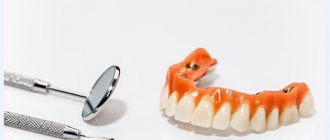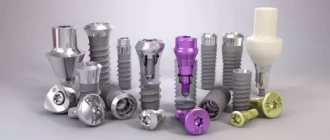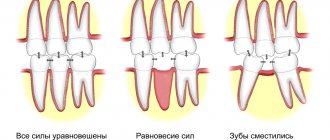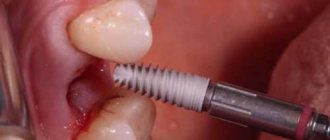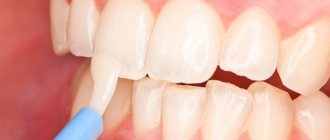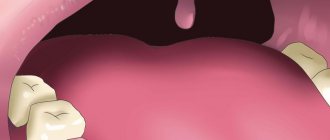What can be put in place of an extracted tooth?
There are many options for replacing an extracted tooth. An experienced orthopedic surgeon will offer removable and fixed structures, solutions for restoring individual teeth or a number of missing units, and reconstruction of a completely edentulous jaw. For each case, protocols, methods, and treatment techniques are provided.
How to insert a tooth in place of a removed one - options:
- prosthetics on dental implants;
- bridge prosthesis;
- removable prosthetics;
- clasp prosthesis.
What can be put in place of an extracted tooth depends on:
- number of units removed;
- condition of bone tissue;
- dental diagnoses;
- patient's age.
Based on the preliminary diagnosis, the doctor makes a decision on the timing and features of treatment.
Temporary prosthetics
Removable appliances, bridges and other prosthetics can take a month or more to make. But it is necessary to restore a lost front tooth as quickly as possible. For these purposes, provision is made for the installation of temporary prostheses. Their wearing is indicated until the permanent structure is ready and in a number of other cases.
Temporary devices are made of plastic, since there are no strict requirements for them. Plastic products are intended for short-term use, which is justified by the low cost of the material.
How long does it take for gums to heal after tooth extraction for dental prosthetics?
How many days after extraction you can insert teeth determines the speed of healing of the hole. The process is individual for everyone and depends on many factors:
- type of removed unit - incisor, canine, molar, premolar;
- complexity of the operation - simple extraction or removal with dissection of the gums and sawing of the crown;
- features of the root system - compact, even roots or sinuous, strongly curved, occupying a large area;
- The doctor’s professionalism and experience determines the size of the extracted tooth socket and the likelihood of complications.
How long after tooth extraction can you get dentures?
How long after tooth extraction you can get dentures depends on the speed of tissue healing. Average indicators of restoration of gums and bone structures:
- the first 2 hours after removal - the hole fills with blood, a blood clot forms;
- a week after surgery - the wound heals, new gum tissue forms;
- after 4-6 months, the bone tissue is restored, completely filling the space of the socket.
For removable and fixed dentures, crowns on implants and bridges, different treatment periods are provided:
- removable dentures - in 3-7 days, how will it be possible to make an impression for the manufacture of a prosthetic structure;
- bridges - in a month or two, after complete healing of the tissues;
- prosthesis on implants - depending on the protocol, immediately or after a few months.
If the patient immediately plans to insert a tooth in place of the extracted one, it is better to make an appointment with an implant surgeon. The doctor will prepare directions for mandatory examinations, conduct careful removal, and offer optimal options for restoring the dentition.
Methods for restoring a lost front tooth
If a front tooth has fallen out or been removed, then aesthetics is a very important aspect. The front teeth are a smile, this is a person’s appearance. The absence of a tooth in such an aesthetically important area significantly reduces a person’s quality of life. There may be several treatment options here.
Method 1: implant installation
It’s worth saying right away that installing an implant in the area of a missing tooth will be the most reasonable and least traumatic solution to the problem. Installing an implant involves implanting a titanium tooth root into the bone and then installing a crown on it. This design has a long service life, does not affect neighboring teeth and ensures complete restoration of the function and aesthetic properties of the teeth.
Method 2: installation of a bridge
Other options for restoring a tooth lost due to various reasons may be orthopedic methods, which are bridges and removable dentures. The most important and rather significant disadvantage of bridges in the oral cavity is its traumatic nature in relation to neighboring teeth. To make a bridge structure, the doctor needs to determine the supports on which the prosthesis will be fixed. There can be 2 such supports (2 teeth on each side of the missing one) or even more. In accordance with this, each supporting tooth must be processed and prepared for a crown, which will be part of the prosthesis. In some cases, the choice of several supports (more than 2) depends on the condition of the teeth, the area of the fallen or extracted tooth and the number of missing teeth. In addition, the disadvantage of bridges is the possible deterioration of the condition of the supporting teeth after the expiration of the service life of the prosthesis. If it is necessary to replace it, the supporting teeth, as a rule, do not satisfy all the necessary requirements, as a result of which it is necessary to take more teeth as supporting teeth or change the treatment method.
Method 3: installation of a removable denture
Another treatment option is a removable denture, which replaces the missing tooth. Such a prosthesis also needs support, not with the help of crowns, but with the help of special clasps (hooks that cling to adjacent teeth). In addition to the low aesthetic properties of this prosthesis, wearing it over time causes atrophy of bone tissue in the area of the removed or fallen tooth, which can create certain difficulties if it is necessary to change the design.
Method 4: installation of pin structures and inlays
Another method of orthopedic dentistry is pin structures and inlays. These are special metal structures, on one side they have a pin that is fixed in the root of the tooth, on the other side there is a stump of the prepared tooth, and the crown is fixed on the part. With their help, you can restore a tooth if only the root remains. After treating the root and filling it, a pin-stump inlay is made, which serves as a tooth stump, onto which the crown is subsequently fixed, and the inlay pin strengthens the root and makes the final structure strong. The inlay is not visible under the crown, which gives high aesthetic properties to this treatment method. The inlays have found wide application and are successfully used by many doctors. In this case, the key role is played by the condition of the broken tooth, namely the remaining root. If the root allows the use of an inlay, then such a tooth can last for quite a long time. With such designs, the level of bone tissue is preserved, which allows for implantation after the expiration of the service life of the inlay and crown.
The most optimal way
Based on all of the above methods, in the absence of a tooth, it is better to place dental implants, since this method is the least traumatic, meets functional and aesthetic requirements, has a long service life and maintains the volume of bone tissue at the required level. Implantation is also the most optimal treatment method for complete absence of teeth. In such situations, there are several methods; in any case, implants are the most optimal solution. Several implants can support the load of the entire jaw.
Prosthetics on implants are also variable. Each patient will be able to choose the appropriate option for himself. The hygiene of structures fixed on implants is also very convenient for both the patient and the doctor. Regular visits to the dentist for preventive examinations allow you not only to maintain the proper level of hygiene, but also to monitor the dynamics of the condition of the bone tissue and the condition of the implants in the bone.
Depending on the age of the patient, various types of dental restoration are recommended, we are talking about implantation and removable prosthetics, which can be used in the case of an extremely small volume of jaw bone tissue and the impossibility of installing implants. In such cases, removable dentures are the treatment of choice for the patient. If it is possible to install at least 4 implants, then you should give preference to the surgical method!
Bridge prosthesis in place of an extracted tooth
The design of a dental bridge consists of the main crowns for replacing missing units and two additional ones for fixing the prosthesis on the jaw. During the treatment process, the doctor grinds down the living teeth and attaches crown caps to them. Advantages of a dental bridge for the patient:
- durable permanent installation;
- affordable price;
- aesthetics.
Flaws:
- Delayed prosthetics. The minimum period when a bridge can be installed after tooth extraction is a month after the operation.
- Grinding healthy units. Physical damage to the integrity of the enamel and partially crowns.
- Excessive load on supporting teeth. And degradation of bone tissue under the overhanging part of the denture.
- Gradual loss of aesthetics and functionality. Due to tissue subsidence, a gap is formed between the denture and the gum, visible when speaking. Also, food particles get into the empty space, which often causes inflammation.
- Fragility. The prosthesis and supporting teeth are usually removed 5-7 years after installation.
Doctors explain not only how long after tooth extraction a bridge can be installed, but also why. 4-8 weeks is a reasonable interval, since the tissue at the site of the lost tooth should be completely restored. Otherwise, there is a risk of changing the shape of the gums under the installed prosthesis, and the likelihood of tissue injury at the time of prosthetics increases.
CONSIDER THE FOLLOWING PROS AND CONS
The traditional prosthesis, which rests on adjacent teeth, has the disadvantage that it does not provide the proper load on the bone tissue, which will inevitably soon lead to a decrease in its volume. Proper pressure, as well as nutrition of bone tissue with oxygen, blood, and necessary nutrients, can only be achieved after the installation of good dental implants.
When choosing the option of a fixed prosthesis that will be attached to your own neighboring teeth, it is impossible to avoid significant grinding of them, and in some cases even depulpation and installation of stump inlays. You should not take the advice of a dentist, who will probably recommend this option to you, as an opportunity to “extract” additional funds from you. Practice has long proven that dentures on stump inlays serve the client much longer, and there are practically no complications with them.
To summarize, it can be noted that implantation of an artificial tooth root, which will serve as a support for the subsequently installed prosthesis, is perhaps the best and most gentle solution to this issue. A good option is to install an implant, especially considering that today it is already possible to install it immediately (immediately after removing a natural tooth). Similar to the option with prosthetics, the main condition for performing an operation to install an implant in the socket of an extracted tooth is the absence of any inflammatory processes.
This requirement cannot be neglected, since in this case the likelihood of implant rejection increases. It is optimal when the operation of tooth extraction and implantation is carried out by the same specialist, or, in extreme cases, in the same clinic. The reason for this is the special requirements that apply to tooth extraction and subsequent implantation. One of them is the most gentle tooth extraction, preserving as much bone tissue as possible near the tooth being removed. It is not recommended to loosen a tooth that is being removed.
Removable prosthetics
A removable denture is recommended when several units are removed or when the entire jaw is missing. For a single replacement, doctors recommend a temporary option - an immediate prosthesis, which is placed in place of the removed incisor or canine to preserve aesthetics. Then the product is replaced with a permanent and more convenient to wear option.
For removable prosthetics of one tooth, a high-quality impression of the jaw is required, which is made 3-4 days after the extraction operation. To make extended structures for several teeth, doctors recommend waiting until the tissue is completely restored. It takes about 30 days for the gums to heal before prosthetics.
Permanent prosthetics
Permanent dentures are designed for long-term use. Some can last several decades.
- Bridge prosthesis
Allows you to recreate several adjacent teeth. The support is represented by two crowns, and the required number of artificial teeth is located in the center. Typically, bridges are made of metal-ceramic or zirconium dioxide, which provides strength and aesthetics.
The disadvantages include the need to grind the support units.
- Lamellar
A removable denture, which is a support in the form of gums with artificial units. Installed in patients after extraction of chewing teeth on both sides of the dentition.
Acrylic or polymer is used for manufacturing. The main advantage of plate structures is considered to be affordability. During the process of getting used to it, you may feel some discomfort. In addition, such prostheses have a short service life.
- Clasp
A prosthesis made in the shape of gums with artificial units. The difference from the previous ones is the presence of a metal arc (clasp). The latter is responsible for uniform distribution of the chewing load, avoiding damage to the crown.
They have a longer service life than plate ones, but their cost is higher.
Crown instead of an extracted tooth - implantation
Implantation is a modern solution for partial and complete adentia. This is what doctors recommend to patients, and there are many reasons for this:
- complete replacement of a lost tooth - not only the upper part, but also the root system;
- restoration of chewing and other functions - after prosthetics, the patient is not limited in the choice of menu, and the quality of speech does not suffer;
- aesthetics - both the crown itself and the artificial gum contour, if present, look natural;
- preservation of bone tissue - bones experience full load, which eliminates atrophy and degradation of bone structures;
- speed of prosthetics - some protocols allow you to restore a tooth immediately after removal.
Implantation options:
- Classic two-step protocol. After removal, the doctor waits for complete healing of the gums and restoration of soft and bone tissues. Then he installs the implant and, after its complete engraftment (4-6 months), places an artificial crown or bridge on the implants without damaging neighboring units. The treatment is long and is recommended for patients who, immediately after extraction, were unable to replace their teeth with prosthetics - the socket has healed, and the tissues have partially atrophied. It is possible to speed up treatment using a two-stage protocol. Premium dental implants Nobel, Strauman take root in 2-4 months, which reduces the period of prosthetics by half.
- One-stage implantation protocol. When a tooth is removed, the patient is immediately implanted with an implant, a gum former or a full-fledged temporary crown. Such treatment requires removal by an experienced implant surgeon, as well as preliminary examination to reduce risks.
- One-stage implantation protocol. It completely eliminates the question of when a tooth can be replaced with a prosthetic after extraction, as it combines all three stages of treatment. The doctor performs an extraction, places a dental implant and immediately loads it with a crown. The patient simply replaces the damaged tooth with a new artificial one, which significantly speeds up the recovery process.
Total prosthetics after tooth extraction
The situation is considered separately - the removal of all teeth immediately before prosthetics. In this case, the patient is faced with complete adentia, which requires emergency treatment.
Option two:
- Removable prosthetics - quickly, inexpensively, with guaranteed atrophy of bone tissue subsequently, frequent replacement of the prosthesis and inconvenience of wearing the product.
- Implantation with installation of a fixed prosthesis - according to all-on-4 or all-on-6 protocols. The essence of the treatment is the installation of a fixed number of dental implants and the attachment of a full denture prosthesis to them. Implantation of 4 or 6 artificial roots is performed on the day of removal. An impression is immediately made, from which artificial teeth are made in a dental laboratory. The longest waiting period is 3 days, after which the patient receives a full-fledged jaw capable of withstanding all physiological loads.
In what cases is removal of the upper tooth inevitable?
Medical indications for extraction of the upper tooth can be divided into planned and emergency. The planned ones include:
- periodontal inflammation or the formation of a cyst at the roots of a tooth with impenetrable roots;
- tumors of the upper jaw;
- the presence of unerupted, out of place or extra teeth that cause discomfort (damaging soft tissues, causing speech defects, preventing normal chewing of food, increasing the risk of developing inflammatory processes);
- destruction of the crown that cannot be restored;
- periodontal inflammation, one of the signs of which is pathological tooth mobility;
- fractures of tooth roots;
- the presence of teeth that interfere with orthopedic or orthodontic treatment.
Emergency indications are:
- purulent inflammation of the bone tissue of the upper jaw, occurring in an acute form;
- destruction of the crown of a tooth that has no functional value.
In addition, severe toothaches that cannot be eliminated by conservative methods (for example, in case of complex crown fractures) can be the basis for unscheduled extraction.
Is it necessary to insert a tooth after extraction?
Many patients do not even ask questions about how many days after tooth extraction they can get a crown or dentures. But in vain. Even a short-term absence of a tooth in the jaw row is fraught with serious consequences:
- displacement of adjacent units and teeth of the opposite jaw towards the empty space;
- jaw deformation, malocclusion;
- improper redistribution of chewing loads, gastrointestinal problems;
- deterioration of diction, the appearance of complexes due to aesthetics and speech.
The longer the interval between removal and prosthetics, the more serious the orthodontic defects and the more expensive the treatment.
Installation of a temporary prosthesis
After extraction, an empty area is formed in the dentition. Leaving everything as it is for a long time is extremely undesirable, since even a single adentia causes a number of unpleasant consequences. Among them:
- Displacement of adjacent teeth towards the empty space and weakening of their fixation in the sockets.
- Changes in bite, which can lead to problems with the temporomandibular joint.
- Disorders of the stomach and intestines caused by difficulty in chewing food.
- Changing the shape of the face, weakening the tone of its muscles, thinning of the lips, and the appearance of wrinkles.
So, if a tooth is removed, after what time can prosthetics be done? To prevent the problems listed above, it is advisable to act as quickly as possible. Already three to four days after extraction, you can begin to prepare for the installation of a temporary crown. Such a prosthesis will help quickly eliminate an aesthetic defect, restore chewing function, and prevent adjacent teeth from moving. You can wear it for up to a year.
